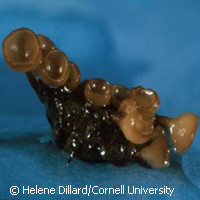Study unveils secret of crop-killing fungal pathogens
Scientists in the US have worked out how fungi manage to reduce drag on their spores so as to spread them as high and as far as possible. They say their discovery could help researchers find new ways to control the spread of fungal pathogens such as sclerotinia that cause various diseases in crops like sunflowers to soybeans, and cost farmers billions of euro every year. The study was funded in part by the EU via a Marie Curie Fellowship worth some EUR 18,000 under the Seventh Framework Programme (FP7). The findings were recently published in the Proceedings of the National Academy of Sciences (PNAS) journal. Using high-speed video to clock the speed of spores ejected by sclerotinia, mathematicians and biologists from the University of California, Berkeley, Harvard University and Cornell University observed that the fungus spews thousands of spores almost simultaneously to form a plume that reduces drag to nearly zero and creates a wind that carries many of the spores 20 times farther than a single spore could travel alone. The spores were expelled at about 8.4 metres per second, but because the spores are so small - 10 microns long - air drag brings them to a stop in a mere 3 millimetres (mm). However, when thousands of spores are ejected at the same time, some can travel more than 100 mm. 'In the Tour de France, riders form a peloton that can reduce air drag by 40%,' said co-lead author Marcus Roper, a postdoctoral researcher in the Department of Mathematics at UC Berkeley. 'The ascospores of Sclerotinia do the peloton perfectly, reducing air drag to zero and sculpting a flow of air that carries them even farther.' Dr Roper and co-lead author Agnese Seminara, a postdoctoral researcher and theoretical physicist in Harvard's School of Engineering and Applied Sciences, used standard equations of hydrodynamics to model spore plume movement precisely. They showed that the thousands of spores ejected at the same time quickly eliminate all drag and allow the spores to travel about a centimetre (cm), by which time the wind generated by the spores captures and whisks them to a speed of 60 cm per second. Their upward motion is stopped only by gravity, according to Dr Roper. Range from 'hydrodynamic cooperation' allows fungi on the ground to shoot their spores into flowers or plant wounds, whereby they can quickly spread throughout the plant and kill it, he pointed out. The researchers were also curious to investigate how fungi manage to eject their spores simultaneously. So they grew another mold, namely a coprophilic fungus from the genus Ascobolus, on horse dung and focused their high-speed video camera on the 2-mm, cup-shaped fruiting body containing tens of thousands of spore sacs, each containing 8 spores. They found that while the spore sac that ejects first seems to be random, after the first one or two go off, a wave of ejection travels outward as successive rings of spore sacs rupture in sequence. Because this happens in one tenth of a second, the ejection seems simultaneous. 'What looks like a plume is actually a series of sheets going off,' Dr Roper explained. By tweaking their mathematical model to take account of this, Drs Roper and Seminara discovered that cooperative ejection in sheets is a highly effective method for shooting spores long distances. They will continue to investigate how spore ejection is initiated, and whether and how spores can cheat to make sure that they get ejected farther than their companions. Commenting on the results of the study, senior author Anne Pringle, associate professor of organismic and evolutionary biology at Harvard, said: 'The findings could have implications for methods of controlling the spread of fungal pathogens. Sclerotinia alone costs US farmers in the order of USD 1 billion [EUR 730 million] annually, including the costs of controlling the fungus and crop losses.'
Countries
United States



